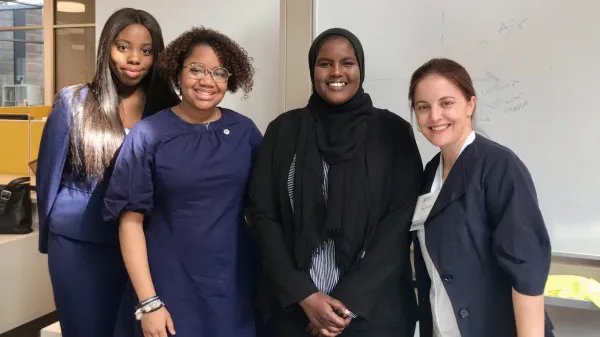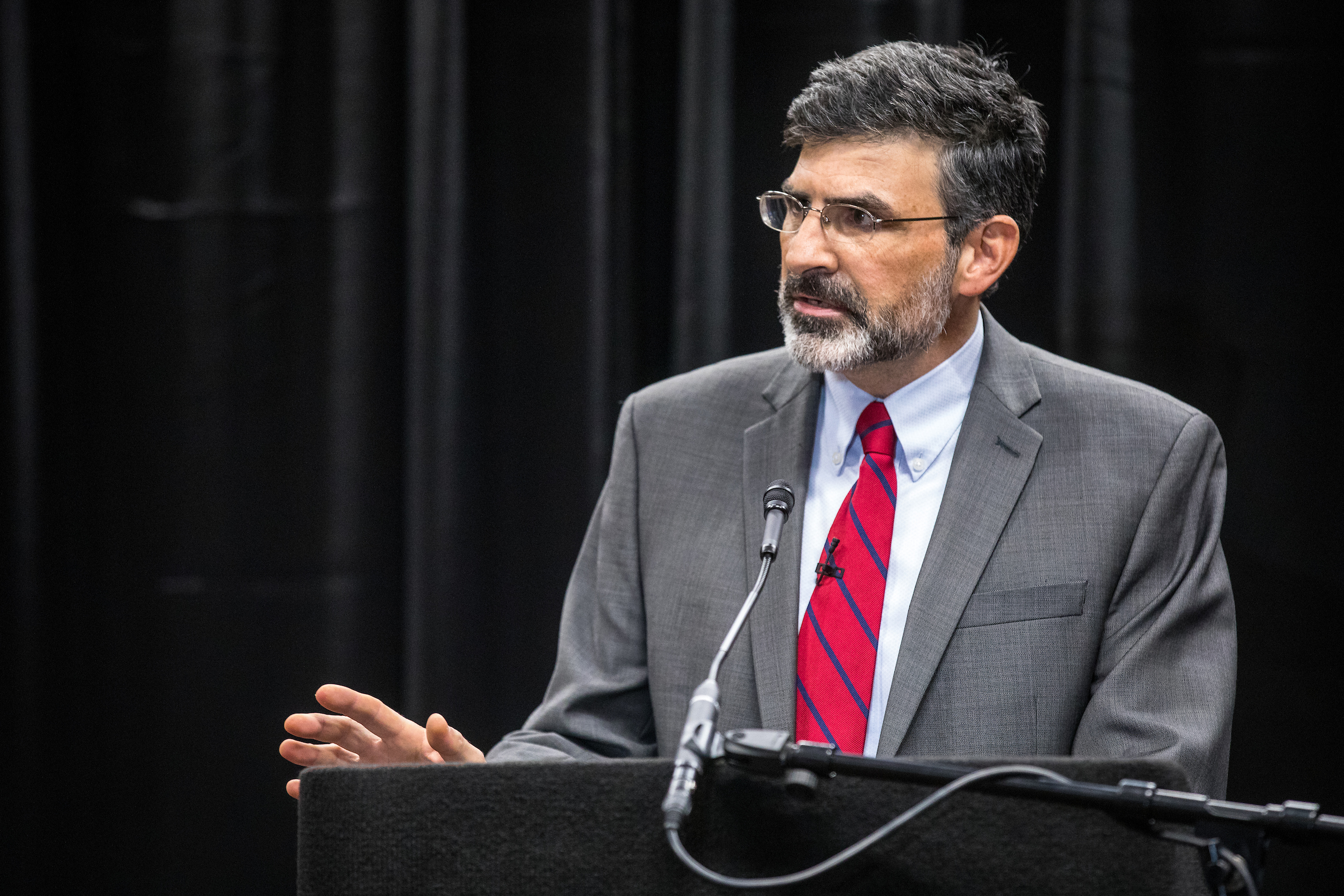Bipartisan hosts of 'The Pollsters' podcast analyze midterm elections at ASU event
Key takeaways: Campaign messaging matters, blue and red states are an outdated concept, GOP lost key voting blocs

It’s official: Arizona is now a battleground state. This, according to Margie Omero, one half of the “The Pollsters” podcast duo rounded out by Kristen Soltis Anderson.
Omero, principal at GBA Strategies with more than 20 years of experience managing all facets of qualitative and quantitative research, and Soltis Anderson, a pollster and co-founder of the research and analytics firm Echelon Insights, visited Arizona State University’s Tempe campus Tuesday evening as guest speakers for the School of Civic and Economic Thought and Leadership’s final 2018 “Polarization and Civil Disagreement” public talk.
Over the course of a couple of hours, a room of about 200 students, faculty, staff and community members listened as Omero, a Democrat, and Soltis Anderson, a Republican, analyzed the results of the 2018 midterm election and reviewed stats, trends and key points.
“It’s really a source of joy to have this bipartisan moment,” Omero remarked at the beginning of the event. “I get a lot of questions about my friendship with Kristen. … We really do get along.”
School of Civic and Economic Thought and Leadership Director and Professor Paul Carrese moderated the discussion, which began with each speaker going over what she determined to be the biggest takeaways.
For Soltis Anderson, there were three:
1. “The polls are all right.”
Following the 2016 election, Soltis Anderson said she gave the polling industry a grade of C-plus because of some key marquee races that they got wrong. However, this time around, she said, “The pollsters got it pretty close to right,” upgrading her C-plus to a B-plus.
2. The idea of red states and blue states is increasingly outdated.
Though several headlines reported red states getting redder and blue states getting bluer, Soltis Anderson believes the density of the area in which you live might tell someone a lot more about how you vote than whether you’re in a “red state” or a “blue state.”
“The last couple elections, suburbs leaned slightly Republican,” she said, but this election showed that the GOP is losing them. “Even if it’s by a small margin, that will have huge electoral consequences, as we saw by the number of House seats Democrats were able to pick up. So looking at a map can be misleading,” because cities that are blue might appear smaller but are more population-dense.
3. Many hugely influential voting blocs moved away from the GOP.
“Typically in a lame election, one party is energized and the other is depressed,” Soltis Anderson said, providing the 2010 and 2014 elections in which Republicans were energized and turned out to the polls, whereas Democrats stayed home, as examples.
This year, though, the shoe was on the other metaphorical foot.
“Given the results,” she said, “President Trump should be nervous about his re-election chances.”
Specifically, Republicans failed to win over married women, and white women with college degrees — who used to split evenly — broke for the Democrats by 20 points. In addition, voters younger than 20 broke for the Democrats by a 30-point margin, the same margin that got Barack Obama elected in 2008.
“Republicans have got to catch up with the demographic of cultural changes (and convey) a message that speaks to a broader group of people,” Soltis Anderson said.
Omero's key takeaways:
1. The expectation that we would see an increase in female candidates and voters was correct.
There are now roughly 100 new members of Congress who are women, and two women ran against each other for a Senate seat in Arizona. Omero said this is something that doesn’t happen very often for a variety of reasons, but two that are notable are a majority of Americans who feel Trump doesn’t respect women and the fact that so many women voted in this election.
“Women really did set the pace, as voters and as candidates this time around, more than even before,” she said.
2. Campaigns and messages matter.
“It’s important to look at individual candidates and how their campaign was run,” Omero said.
Candidates who eschewed demonizing one party over the other and instead focused on issues like health care tended to do better.
3. Candidates struggled with how to talk about Trump.
Whether they were “Trump huggers” or “Never Trumpers,” candidates who expressed an opinion about the president one way or another tended to alienate voters.
School of Civic and Economic Thought and Leadership Director Paul Carrese moderates the Tuesday evening event. Photo by Charlie Leight/ASU Now
Following their debriefings of the midterm results, Carrese posed a handful of questions to the pollsters, ranging from how Republicans might interpret the outcome, to the absence of a dominant party, to how women in office might approach issues differently than their male counterparts.
“If I wanted to construct a case why this was a good night for Republicans, there are data points that would let me do it,” Soltis Anderson said. “However, that doesn’t necessarily mean this was a good night. If you lose a chamber of Congress, I think you in some ways lose the right to say you had a good night.”
Soltis Anderson also lamented the tendency of success to breed complacency.
“I think in politics, people think very short term,” she said. “I don’t think one party has figured out the magic formula and are going to be winning forever. … (At the moment), the polls are still trending … against Republicans.”
Though many are celebrating the unprecedented female presence in political offices following the election, Omero cautioned that it doesn’t necessarily mean there will be a sea change in governing.
“Women don’t have to be better or even different in order to deserve parity in public life,” she said. “Women don’t have to be more collegial or more cooperative … or any of that. It’s just great to have more diverse representation.”
The evening closed with questions from the audience. Several came from students affiliated with the Young Democrats, the College Republicans, Bridge ASU and Undergraduate Student Government.
Hanna Salem, a member of the Undergraduate Student Government on the Tempe campus, asked about the role of student organizations to promote civic engagement.
While conventional wisdom says that young voters don’t participate, Soltis Anderson felt this election was an exception and that particularly on college campuses, peers have the power to influence one another.
“This is a really big school in what is now considered a battleground state,” Omero added. “You guys hold all the cards.”
The “Polarization and Civil Disagreement” series will continue in 2019, picking up Jan. 24 with a talk titled “Bringing America Together” with Arthur Brooks.
Top photo: Kristen Soltis Anderson (left) and Margie Omero, hosts of the podcast "The Pollsters," offer their bipartisan views on the 2018 midterm elections at the Memorial Union on Tuesday evening. More than 200 people listened to the discussion, part of the School of Civic and Economic Thought and Leadership's annual lecture series on "Polarization and Civil Disagreement." Photo by Charlie Leight/ASU Now
Video by Jamie Ell/ASU Now
More Law, journalism and politics

School of Politics and Global Studies director's new book explores mass violence
Why do people commit atrocities and why are certain groups, including religious and ethnic, more vulnerable to large-scale violence? These questions are explored in a new book by Güneş Murat Tezcür…

ASU faculty contributing to improvement of Wikipedia
Many academics have a love-hate relationship with Wikipedia. While the website has information about almost anything you can imagine, the credibility of that information is sometimes suspect. Tracy…

ASU Law students gain vital experience through Los Angeles location
Students at the Sandra Day O’Connor College of Law at Arizona State University may be concentrated in the school’s downtown Phoenix headquarters, but they have more choices than ever when it comes to…
